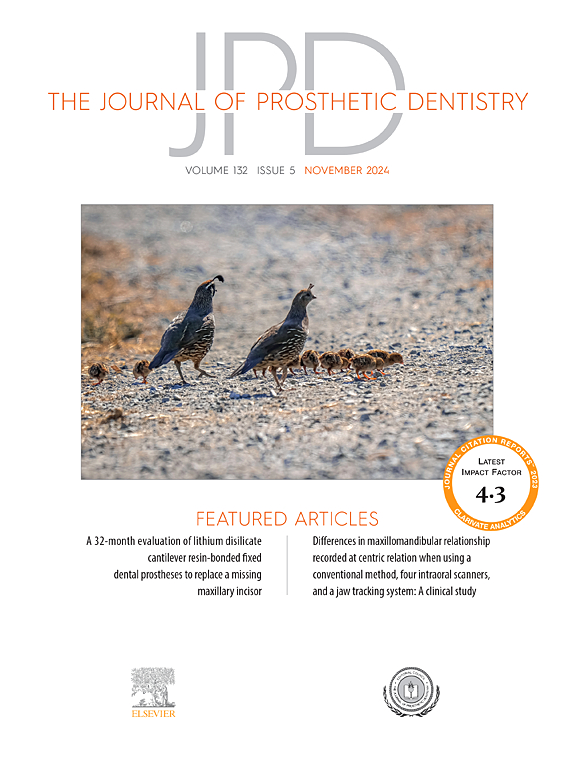A two-year clinical trial of enamel wear opposing 5Y-TZP and lithium disilicate crowns
IF 4.3
2区 医学
Q1 DENTISTRY, ORAL SURGERY & MEDICINE
引用次数: 0
Abstract
Statement of problem
Clinical information on enamel wear opposing 5 mol% yttria-stabilized tetragonal zirconia polycrystal (5Y-TZP) or lithium disilicate crowns is lacking. Moreover, the effect of surface roughness on the wear of enamel antagonists remains unclear.
Purpose
The purpose of this clinical study was to quantify the vertical wear and total volume of wear while also measuring the surface roughness of antagonists at 6-month intervals over 2 years.
Material and methods
A tooth-supported first molar 5Y-TZP Lava Esthetic Fluorescent Zirconia crown or an IPS e.max CAD lithium disilicate crown was randomly provided for 24 participants (n=12). The contralateral first molar and opposite teeth were the natural enamel controls. The crowns were fabricated using computer-aided design and computer-aided manufacturing (CAD-CAM) technology and then polished. The data were gathered every 6 months at recall appointments with an intraoral scanner and a polyvinyl siloxane impression. A 3-dimensional (3D) comparative software program was used to measure the maximum vertical and volume loss on opposing enamel, as well as on the enamel control on the opposite side of the mouth. The surface of epoxy resin replicas was analyzed using a scanning electron microscope. The surface roughness of the cusp replica was measured with a 3D laser microscope. The crown's antagonist enamel and natural enamel wear were compared using a 2-way repeated measure ANOVA (α=.05).
Results
No significant difference was found in the average volume loss between the crown's antagonist enamel (ZTE 0.042 ±0.005 mm3, LTE 0.048 ±0.006 mm3) and the enamel control (ZCE 0.046 ±0.004 mm3, LCE 0.050 ±0.005 mm3) (P>.05). No significant difference was found in surface roughness between the crown's antagonist enamel (antagonist enamel of zirconia group [ZTE] 0.7 ±0.3 µm, antagonist enamel of lithium disilicate group [LTE] 0.6 ±0.3 µm) and the enamel control (enamel control of zirconia group [ZCE] 0.7 ±0.3 µm, enamel control of lithium disilicate group [LCE] 0.5 ±0.2 µm) in both zirconia and lithium disilicate groups (P>.05). Also, no correlation was found between the amount of wear and the roughness of the surface. The wear patterns observed on the opposing enamel surfaces of the monolithic zirconia and lithium disilicate materials were found to be similar to those seen on natural enamel.
Conclusions
A 2-year clinical investigation found that polished lithium disilicate and 5Y-TZP crowns did not affect enamel wear more than enamel against enamel, contrary to laboratory studies. Another finding revealed that surface roughness did not significantly affect wear.
为期两年的 5Y-TZP 和二硅酸锂牙冠牙釉质磨损临床试验。
问题陈述:目前还缺乏关于5 mol%钇稳定四方氧化锆多晶(5Y-TZP)或二硅酸锂冠釉质拮抗剂磨损的临床资料。此外,表面粗糙度对珐琅质拮抗剂磨损的影响仍不清楚。目的:这项临床研究的目的是量化垂直磨损和总磨损量,同时测量拮抗剂的表面粗糙度,时间间隔为 6 个月,为期 2 年:随机为 24 名参与者(12 人)提供一个牙齿支持的第一磨牙 5Y-TZP Lava Esthetic 荧光氧化锆冠或 IPS e.max CAD 二硅酸锂冠。对侧第一磨牙和对生牙为天然釉质对照组。牙冠采用计算机辅助设计和计算机辅助制造(CAD-CAM)技术制作,然后抛光。每 6 个月在复诊时使用口内扫描仪和聚乙烯硅氧烷印模收集数据。使用三维(3D)比较软件程序测量对侧牙釉质以及对侧牙釉质对照的最大垂直度和体积损失。使用扫描电子显微镜分析了环氧树脂复制品的表面。用三维激光显微镜测量了尖牙复制品的表面粗糙度。使用双向重复测量方差分析(α=.05)比较了牙冠拮抗剂釉质和天然釉质的磨损情况:牙冠拮抗剂釉质(ZTE 0.042 ±0.005 mm3,LTE 0.048 ±0.006 mm3)和釉质对照组(ZCE 0.046 ±0.004 mm3,LCE 0.050 ±0.005 mm3)的平均体积损失无明显差异(P>.05)。牙冠拮抗剂釉质(氧化锆组拮抗剂釉质 [ZTE] 0.7 ±0.3 µm,二硅酸锂组拮抗剂釉质 [LTE] 0.6 ±0.3 µm)和氧化锆组和二硅酸锂组的釉质对照组(氧化锆组釉质对照组 [ZCE] 0.7 ±0.3 µm,二硅酸锂组釉质对照组 [LCE] 0.5 ±0.2 µm)(P>.05)。此外,磨损量与表面粗糙度之间也没有相关性。在整体氧化锆和二硅酸锂材料的相对牙釉质表面观察到的磨损模式与在天然牙釉质上观察到的磨损模式相似:一项为期两年的临床调查发现,与实验室研究相反,抛光的二硅酸锂和5Y-TZP牙冠对珐琅质磨损的影响并不比珐琅质对珐琅质磨损的影响大。另一项发现表明,表面粗糙度对磨损的影响并不明显。
本文章由计算机程序翻译,如有差异,请以英文原文为准。
求助全文
约1分钟内获得全文
求助全文
来源期刊

Journal of Prosthetic Dentistry
医学-牙科与口腔外科
CiteScore
7.00
自引率
13.00%
发文量
599
审稿时长
69 days
期刊介绍:
The Journal of Prosthetic Dentistry is the leading professional journal devoted exclusively to prosthetic and restorative dentistry. The Journal is the official publication for 24 leading U.S. international prosthodontic organizations. The monthly publication features timely, original peer-reviewed articles on the newest techniques, dental materials, and research findings. The Journal serves prosthodontists and dentists in advanced practice, and features color photos that illustrate many step-by-step procedures. The Journal of Prosthetic Dentistry is included in Index Medicus and CINAHL.
 求助内容:
求助内容: 应助结果提醒方式:
应助结果提醒方式:


